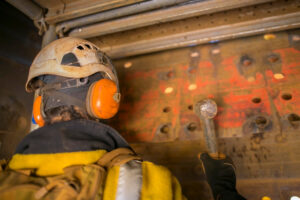Chemicals called ototoxicants or ototoxic chemicals can cause hearing loss, John Howard, MD, director of the National Institute for Occupational Safety and Health (NIOSH), wrote in his From the Director’s Desk column in the institute’s December eNews.
Substances in the workplace that can cause hearing loss include cancer-treating (antineoplastic) drugs, degreasers, fuels, lead, mercury, pesticides, solvents, and tobacco smoke. Exposure to ototoxic chemicals can cause damage to different parts of the ear, increasing a person’s sensitivity to the harmful effects of noise or resulting in hearing loss.
Workers can be exposed to ototoxic chemicals by breathing them in. They also can absorb a chemical through the skin or consume food or drinks that have been contaminated, according to NIOSH. Once exposed, ototoxic chemicals can travel through the bloodstream. They can injure the inner ear or damage the nerves that transmit information to the brain.
The institute recently updated its NIOSH Noise and Occupational Hearing Loss webpage, adding information about ototoxic chemicals, industries known to use them, and ways to reduce worker exposure.
Steps that workers can take to protect themselves from ototoxic chemicals include:
- Reading and following all requirements in each chemical’s Toxicological Profile;
- Wearing personal protective equipment, such as gloves resistant to the chemical(s) of concern, long sleeves, and eye protection, as needed, and wearing hearing protection to prevent the effects of noise; and
- Considering all risk factors and how to control them if exposed to possible hazards.
Counterfeit N95 challenge winners announced
NIOSH also announced the winners of its Counterfeit N95 Challenge. The goals of the challenge are to develop innovative approaches to reduce the number of counterfeit N95 respirators in the marketplace and improve the confidence of end users who purchase filtering facepiece respirators (FFRs).
“Because counterfeit products are not genuine NIOSH-Approved respirators, there is no way in knowing if they meet NIOSH’s strict testing requirements and this means they may not provide the appropriate level of respiratory protection,” Maryann D’Alessandro, director of NIOSH’s National Personal Protective Technology Laboratory, explained in a statement.
The winning solution, N95 FFR Validation App and Website, demonstrated how a validation database with a private-label lookup function and one-way communication with NIOSH’s Certified Equipment List (CEL) could improve user confidence that respirators are authentic. The app includes a prototype of visual validation whereby app users can see pictures obtained directly from the manufacturers’ websites and compare them against the respirator they’re assessing. The winner, Essayon Engineering, will receive a $35,000 prize.
Three teams received honorable mentions, which have no monetary prize attached. However, the teams will be invited to upcoming NIOSH partner activities to share and promote their solutions.
Honorable mentions include:
- Digital Title by Team Digital Title—A decentralized, distributed title recording system that demonstrates respirator proof of ownership to end users. End users can check if their respirator is authentic by entering a QR code incorporated into the product packaging.
- Verisku by Leigh Brand’s Team—A cloud-based platform that uses intelligent event monitoring and initiates media outreach to communities affected by a respiratory health threat to provide information on how to authenticate NIOSH-approved respirators.
- Ethos-Authentication Standards for NIOSH Registry—A registry developed by Team Aegle–Provenio allowing manufacturers to upload and share provenance data across the supply chain to ensure a respirator’s compliance and authenticity.

